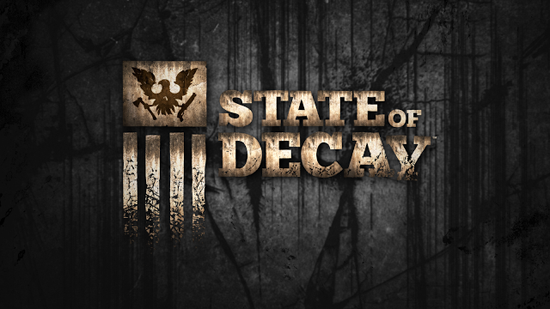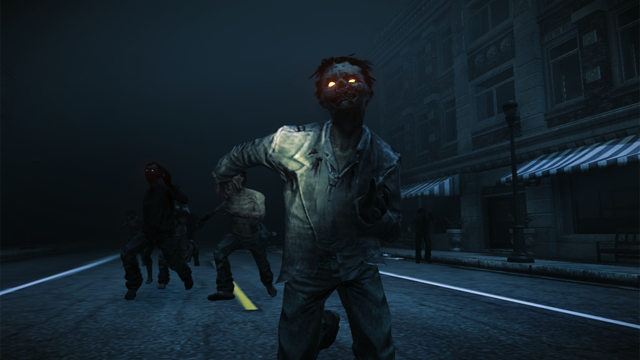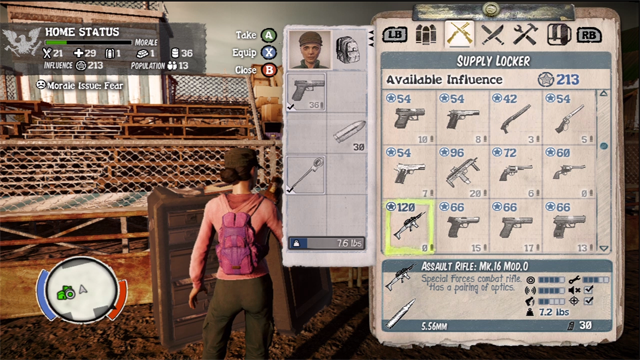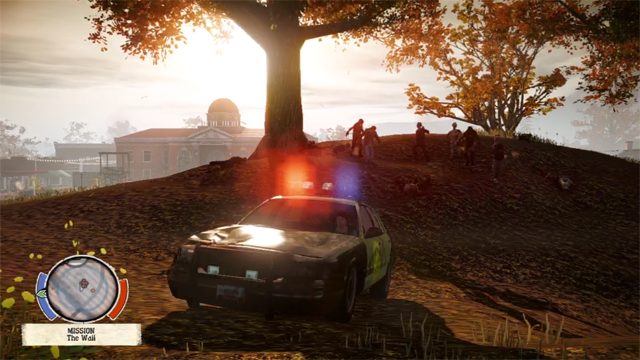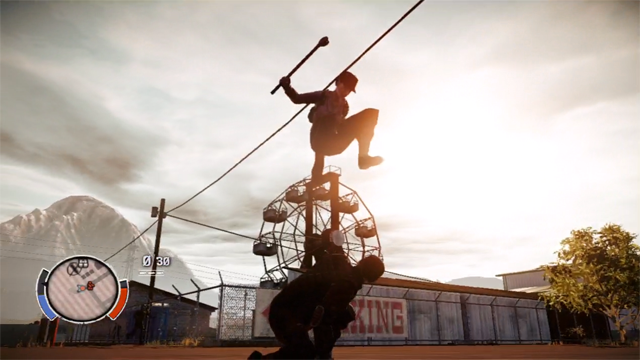State of Decay review (XBLA)
State of Decay was developed by Undead Labs and published by Microsoft Studios. It was released June 5, 2013 for 1600 MSP. A copy was provided for review purposes.
When a collection of zombie-obsessed game industry veterans formed Undead Labs, their sole passion was to play in the ashes of fallen society. They would craft an open sandbox world and fill it with extinction-level contagion. They’d insist upon hard decisions and scraping by one day at a time, and in return, you’d be afforded the opportunity to live out your fantasies in a simulated zombie apocalypse. Now, so many years after that kernel of an idea was born, State of Decay narrowly misses the mark, drooped under its own weighty ambition.
Yet, despite its flaws, State of Decay aims so high that it achieves something many games never aspire to reach. Like the apocalypse it portrays: once the shock and awe begins to wane, once we accept the imperfections of the world, there’s joy to be found and a story to write. As you ponder the layout of your temporary shelter, tally up your resources and balance the fragility of your flock, it becomes clear there’s something special about State of Decay residing around its rough edges. It’s an experience unlike many other, and uncovering it is well worth the investment.
Here’s what we liked:
Weapon of choice – The core tenet behind State of Decay has always been the freedom of choice. While there are limitations to this freedom, it’s undoubtedly the driving force behind the day-to-day experience and the vast majority of gameplay. You’ll make large strategic decisions like where your community holes up: the church, the warehouse, the office building. You’ll make smaller tactical determinations once you leave the snug confines of your walled compound. What threats necessitate immediate action? What member is best suited for the task? What weapons, tools and resources can be spared this time around? It’s an effective marriage of player ability, resource management and community foresight. You’re responsible for your own progression, tested at every turn with ever-increasing stakes, and your answers are never right or wrong.
Diagram not to scale – Throughout the course of your time in the devastated Trumbull Valley, the feeling of scale is pervasive. It’s easy to get lost in the details of the here and now: the infested burger joint two blocks down, the dwindling .45 caliber rounds in your inventory, Ed’s repeated depression contaminating group morale. Though stepping back, looking at the grand scheme of all these systems working in unison is the real sight to see. The scope of State of Decay is massive. Not just the sheer size of the sandbox and its carefully populated vehicles, houses and storefronts, but the systems themselves. Undead Labs’ ambition is reflected in their commitment to personalized survival, and though it’s easy to say that no two experiences will ever be the same, it’s another thing entirely to watch that claim come to life.
Devil’s in the details – Whatever State of Decay accomplishes with lofty expanse is equally complimented by the minute details that flesh out Trumbull Valley as a place that actually exists, both before the apocalypse, and now after. Resources aren’t simply scattered at even intervals for the player to find, instead residing where appropriate. Construction sites may hold building materials, restaurants are a good place to scout for food and scavenging the bathroom cabinets of a residential neighborhood could yield medical supplies. These environmental details lay the groundwork for the genuine thoughtfulness State of Decay strives to create, while aesthetic touches like still-hanging movie posters for Frost Giant Stripper and Clowning Around really go to show how much creativity and effort went into bringing the world to life.
Here’s what we didn’t like:
Technical difficulties – The largest and most apparent drawback to State of Decay manifests itself in the struggling graphics from beginning to end. Though there are moments where the environment looks stunning, like when the morning or evening sun bathes the landscape in fiery light, the overall presentation appears grainy and dated. Large swathes of the world blink in and out of existence while frame rates stumble when prodded by too many moving parts – especially noticeable if driving slightly faster than Miss Daisy prefers. With regard to the interactive elements: enemies often display poor pathing in confined spaces, getting stuck on obstacles, glitching and clipping through walls and under floors. Though it’s never game breaking, suspension of disbelief is quickly shattered when all these elements combine at inopportune moments.
Lose your illusion – Unfortunately some of the potential that State of Decay promises in organic decision-making and tough living has been watered down by elements of gamification. When the same community members must be pep talked or repeatedly rescued from the same stretch of neighborhood, the experience of surviving the apocalypse seems to take a back seat to juggling now-predictable systems and completing randomly generated quests in order to appease a series of status bars. Similarly, once you’ve learned the familiar patterns of the undead and their thresholds for reacting to your presence, the world gets overshadowed by the mechanics of gameplay – the unknown element gets lost.
Fender bender – Though Undead Labs is largely successful avoiding narrative disconnects with gameplay mechanics, State of Decay incorporates designs that hinder these efforts. Vehicles are chief in this department, where nudging zombies at anything faster than an idle roll is simply the most cost effective means of eliminating them. While this is intentionally mitigated by their fragility and scarcity – vehicles are too readily available not to be abused in this way. In the same vein, as the game progresses and you amass a hefty supply of medications, provisions and stimulants, the very real threat of harm that’s so pervasive in the first half of the game collapses upon itself when death and exhaustion can be staved off by instantly slurping an energy drink or popping a handful of pills.
With such passion and focused ambition in making the most diverse and personal take on the zombie apocalypse to date, it’s understandable that State of Decay can’t possibly live up to the all-encompassing simulation that Undead Labs tries so hard to deliver. However, it’s that same passion and ambition that propels State of Decay to a point where the sheer vision and depth solidify the title as something totally unique in spite of the blemishes. This is a game that carries impact; its density and style emerge shortly after the opening and create a blend of gameplay that’s as infectious as any viral outbreak. Though thematically it wanes toward the close of the twenty-plus hours of content, the offering never ceases to be fun and will keep you coming back for more until your ragtag family has escaped or succumbed to a State of Decay.
Score: Buy It

